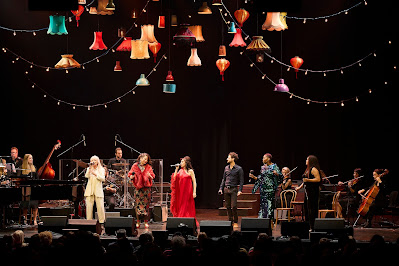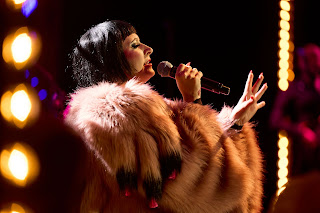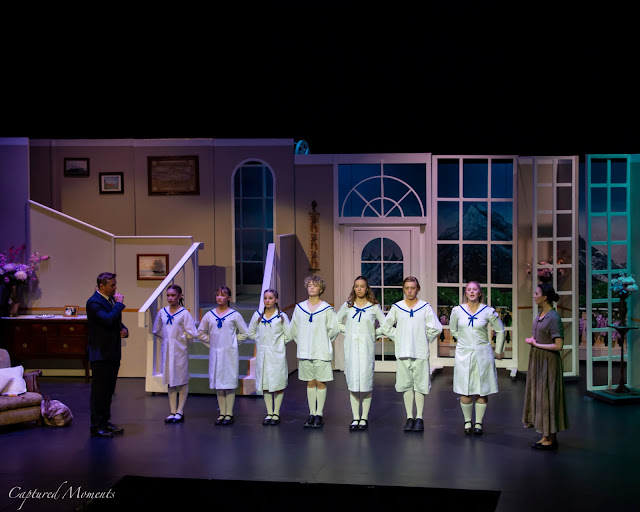Songs My Mother Taught Me.Directed
by Johanna Allen. Musical direction Mark Simeon Ferguson. Special guests.
Sophie Koh, Thando, Wendy Matthews, Jessica Hitchcock and Lior. Her Majesty’s
Theatre. Adelaide Cabaret Festival in association with the Adelaide Festival
Centre. June 25th 2022.
Reviewed by Peter Wilkins

I can’t think of a more fitting
finale to Tina Arena’s stunning 2022 Adelaide Cabaret Festival. The evocative
sound of the didgeridoo, played by Isaac Hannan as his welcome to Kaurna
Country floats through the auditorium. On a stage, colourfully festooned with a
canopy of different lampshades Tina Arena welcomes the audience to her House
Party. We are all invited to share in a very special and unique performance by
musical luminaries from different cultures and diverse legacies. Songs My Mother Taught Me is a salute to
family and the songs of one’s country and culture. Arena is joined in this
extraordinary programme by Canadian Australian Wendy Matthews, Sophie Koh, born
in New Zealand of Chinese/Malay parentage, Zimbabwean Thando, Jessica Hitchcock with family origins in the
Torres Strait and Papua New Guinea and Israeli/Australian Lior. The audience is
in for a world premiere performance like no other, as each artist from wherever
they may be turns to home to sing the songs that they learnt at their mother’s
knee. As Arena tells the audience in Italian and English “No matter where you
go or turn, you will always end up at home.” It holds the promise of nostalgia,
the salute to culture and the affirmation of identity.
 |
| Mark Ferguson and Tina Arena |
Arena opens the show with her memories
of her childhood and the girls’ sunroom in Moonie Ponds. Her rendition of Maledetta Primavera (Cursed Spring),
sung with the aching passion of memory reminds me of the songs in the nighttime
streets of Italy. There is such power in the voice, such passion in the song and
such rich flavor of Italy in the air. She is instantly followed by Sophie Koh
dressed in Chinese design inviting the audience to a call and response in Mandarin
(I want your love.) Seated at the piano, she sings Yellow Rose in words from
the oldest book of poetry in China. It is in our cultural experience that we
learn the lessons of our lives. For Thando, with the spirit of Africa rising
from deep within her soul, her song is the voice of the survivor. “I’m still
here.” she sings in jubilation. This is contrasted with a gentle song that she
sings lovingly to her eight year old daughter at bedtime Lior sings of his old
kindergarten in Tel Aviv, now deserted and neglected. His childhood memory
becomes a plea for compassion. Only then can we hope to be liberated. Backing
singers Susan and Ciara Ferguson join him in perfect harmony.
 |
| Jess Hitchcock |
There is a change
of mood as Jess Hitchcock remembers her mother’s love of 50s and 60s music in a
boisterous and fun filled rendition of Connie Francis’s hit single
Stupid Cupid. Her identity is firmly
bound up with her indigenous legacy and she sings a beautiful rendition of a
song of country in the language of her people. Hitchcock is an emerging artist
of great promise in the company of Tina Arena’s remarkable guests. It is Wendy
Matthews’ rendition of
Cherokee Louise
by Joni Mitchell that strikes to the heart. This heart wrenching song about sexual
and child abuse is sung shortly after SCOTUS hands down its decision to remove
the ROE vs Wade decision legalizing abortion. Her song is a plea for justice and
humanity.
 |
| Wendy Matthews |
Act 2 opens with advice from
Arena to the young Hitchcock to be true to herself and celebrate her family and
individuality in a triumphant duet with Hitchcock of Sorrento Moon. The second half continues with songs that have
formulated these singers. Their spirit is in the song and in their DNA. Lior is
a child of the 1993 Oslo Peace Accord and the 1995 assassination of Yitzchak Rabin.
His longing for peace rings out on his pure tenor voice as he sings a Song for Peace (Shir L’Shalom) Thando continues to exude strength and
resilience with her song about holding on to freedom, inspired by her life in
Canberra after leaving Zimbabwe and Wendy Matthews identifies the influences of
her Scottish heritage. Arena then sings with the voice that could light up a
thousand stars a deeply moving song about her Italian inspiration - the great Enrico
Caruso (Caruso) as he nears the end
of his life in far flung Italian Sorrento. The synchronicity of life soars in
her song. As the evening draws to a close, the family of singers, backed by a
superb string quartet and band under Mark Ferguson’s musical direction, join
together to sing in their own language the lyrics to Lior’s wedding celebration
song This Old Love.. There is joy and
there is family which carries through to the rousing, uplifting Tintarella di Luna. (Suntan of the Moon)
 |
| Lior |
The singers dance happily to Tintarella di Luna as band and backing
singers join in to bring the concert and the Cabaret Festival to a close. Songs My Mother Taught Me is far more
than a collection of songs that have inspired and formulated Tina Arena and her
amazing guests Sophie Koh, Wendy Matthews, Thando, Jess Hitchcock and Lior. The
house party affirms the love of family and humanity, irrespective of colour,
race or creed. What these phenomenal artists, musicians and director Johanna
Allen have brought to this festival is the empowerment of legacy and culture.
Like so many shows during the festival Lone can only hope that they may be
revived after a one night stand. In the meantime I urge readers to google the
singers and their songs to savour the taste of what has been an exrtraordinary performance
and an unforgettable festival.
Photos by Claudio Raschella
I am attaching the full cast, song and musicians list because of the unique, on-off nature of this final performance of the Adelaide Cabaret Festival 2022
ACT 1:
SONGS MY MOTHER TAUGHT ME.
1. OUR
HOUSE (EVERYONE)) Full cast, BV’s and full band (including trombone). New
arrangement that kicks into the original
2. TINA:
MALEDETTA PRIMAVERA Tina, BV’s and full band.
3. SOPHIE
KOH: WO YAO NI DE AI Sophie, BV’s and full band.
4. SOPHIE
KOH: YELLOW ROSE, STRING QUARTET FEATURED. Sophie at piano, strings, BV’s. 5.
THANDO: Survivor (Destiny’s Child) Thando, BV’s and full band.
6. THANDO: Thula Thala Strings and Piano and
BV’s at the end
7. LIOR:
GAN SAGUR Lior, full band and BV’s
8. LIOR:
AVINU MALKEINU (ACAPELLA) Lior a capella
9. JESS
HITCHCOCK: STUPID CUPID. Jess, BV’s and rhythm section
10. JESS
HITCHCOCK PLUS BV SINGERS: BABA WAIYAR Jess, BV’s maybe guitar. mostly a capella
11. WENDY
MATTHEWS: CHEROKEE LOUISE Wendy and full band
12: WENDY
MATTHEWS PLUS ALL: STANDING STRONG. Full cast, BV’s and full band.
INTERVAL.
ACT 2:
SONG MY MOTHER TAUGHT ME.
1;
Intro:mferguson THEN SORRENTO MOON: TINA AND JESS AND PIANO
2. .LIOR: SHIR L’SHALOM
3.
THANDO: GOLDEN FULL BAND AND BV
4. WENDY MATTHEWS: LONG WAY FROM HOME.
(ACAPELLA WITH AUDIENCE PARTICIPATION). Wendy A capella
4A. WENDY
MATTHEWS: LE JOUR OÙ TU ES PARTI /THE DAY YOU WENT AWAY WENDY AND PIANO 5.
SOPHIE KO: GAN LAN SHU. Sophie, BV’s and full band
6. TINA: CARUSO FULL BAND 7. . LIOR ET ALL:
THIS OLD LOVE WHOLE CAST
9. TINA:
TINTARELLA DI LUNA. WHOLE CAST
Mark Simeon Ferguson MD, arrangements, piano,
keyboard, BV’s
Zsusza
Leon, Violin
Emily
Tulloch Violin
Karen DeNardi Viola
Hilary
Kleinig ‘cello
Chris
Neale drums
Cameron
Blokland guitars
Nick
Sinclair basses
Ciara
Ferguson BV’s percussion, piano.
Susan
Ferguson BV’s
































